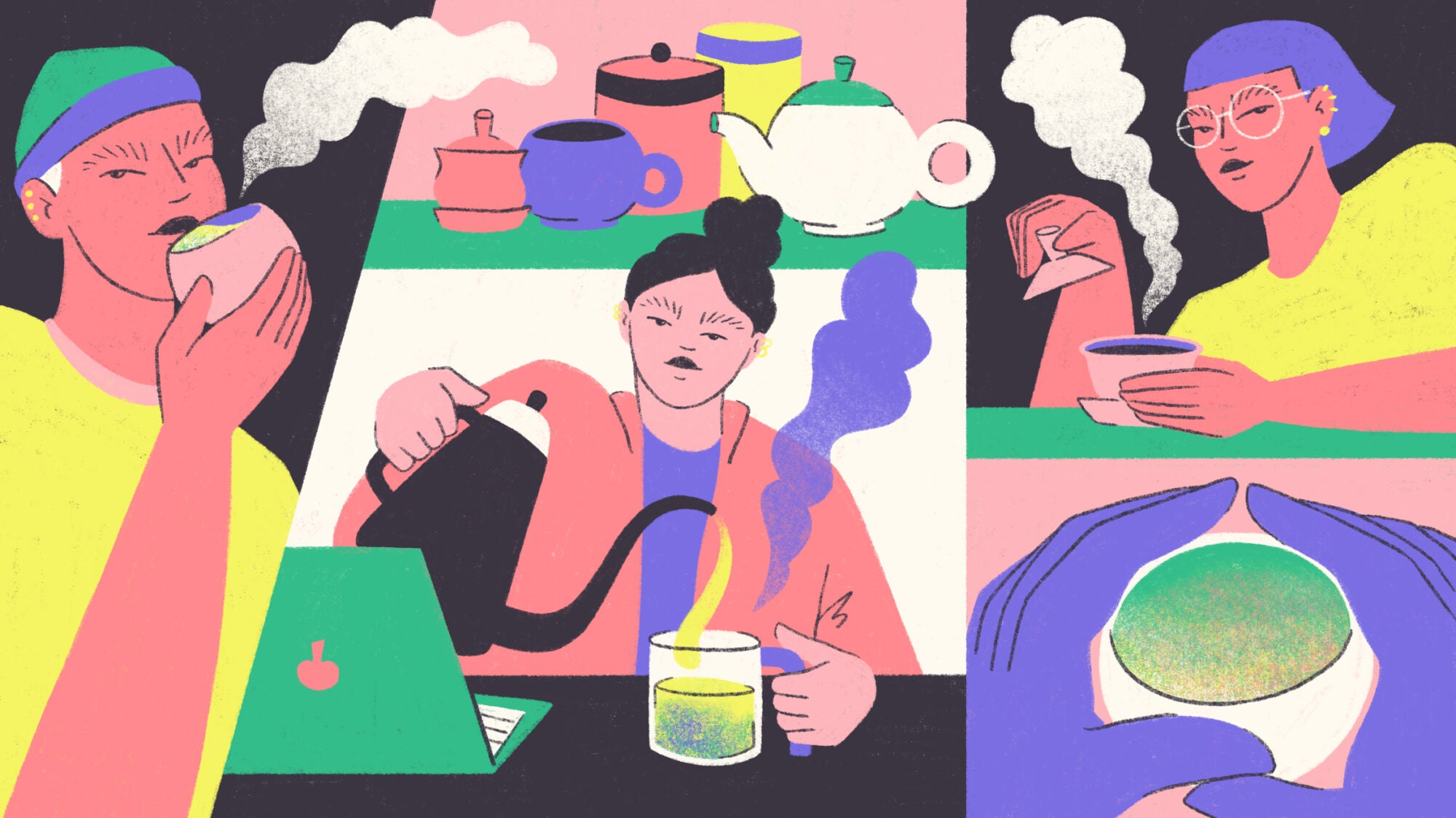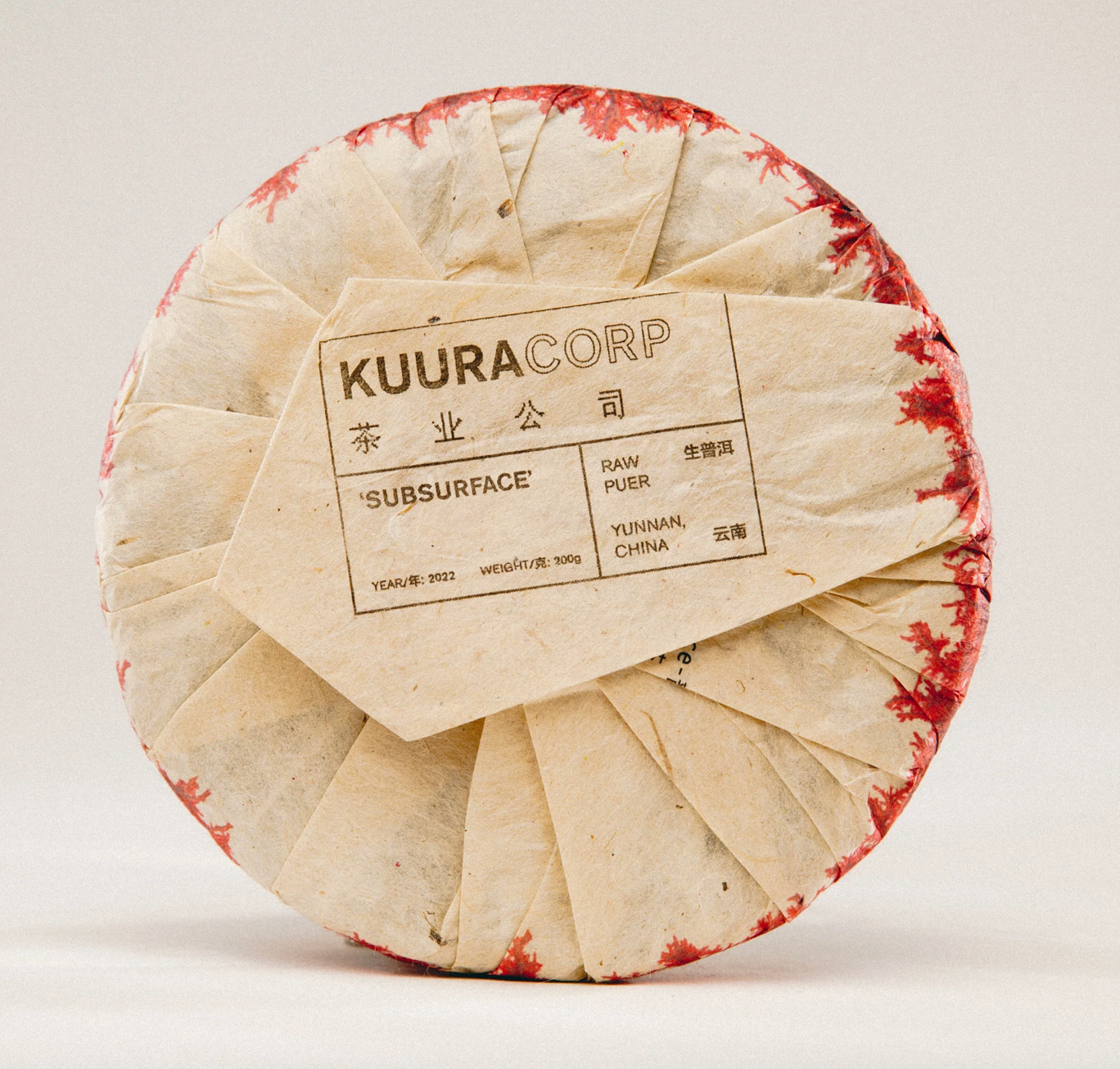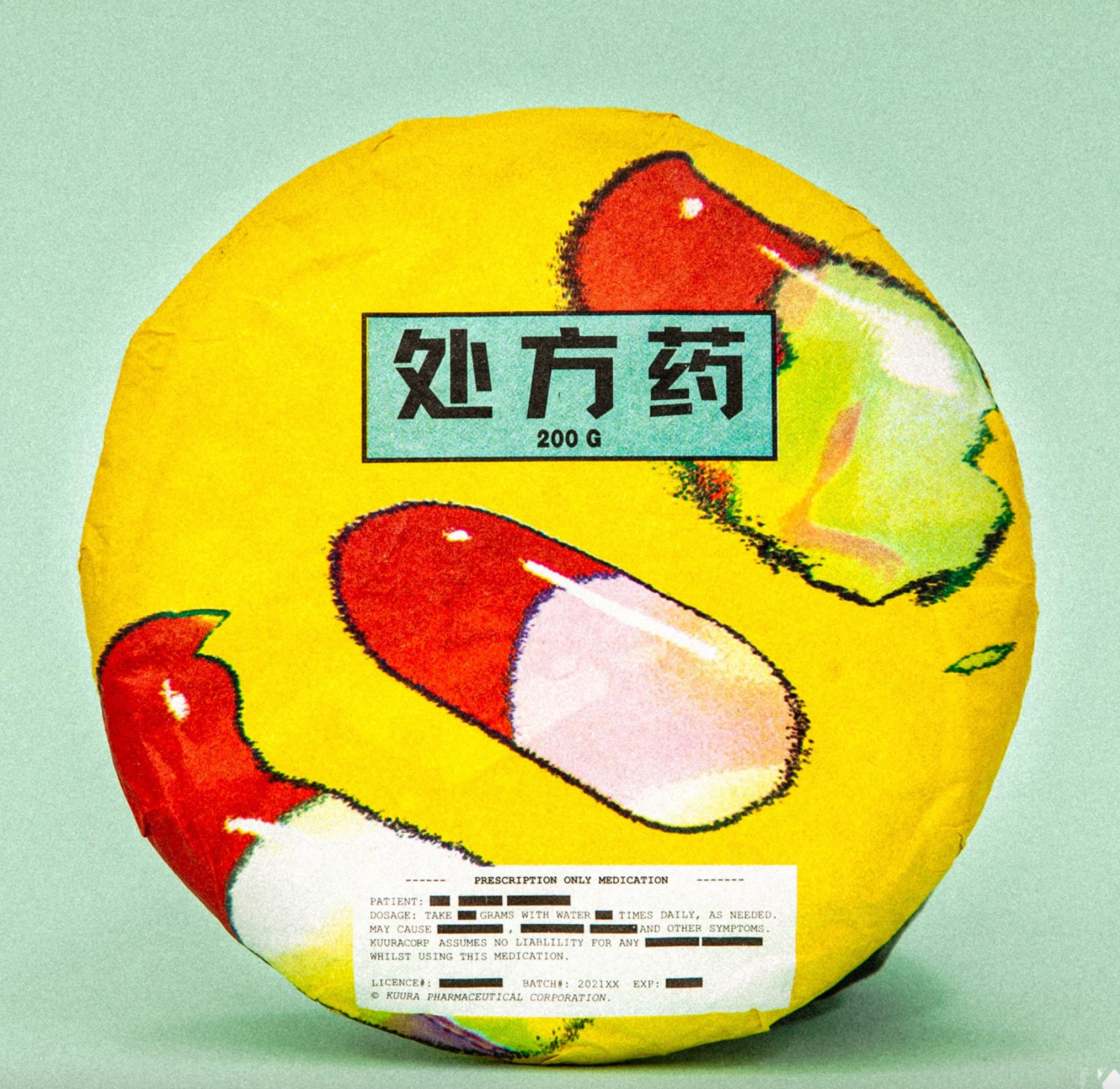
Wine, coffee, whiskey, mezcal, and many other beverages have rich subcultures and legions of admirers. Imagine a world where tea gets an invite to the party.
Wine earns all the editorial think pieces, and coffee gets the five-year leases, but these days I find myself increasingly drawn to camellia sinensis, the drink popularly known as tea. Those blue-green oolongs, licorice pu’ers, rock candy yanchas, and amaro-like Sichuan greens have something to say—and they are no longer content to do it with whispers or play second fiddle behind other, more flashy craft consumption trends. Tea is unbelievably delicious and flavorfully diverse; it’s compelling and historic and urgent and nootropically potent—it is a multiverse, a vast ocean, a deep and abiding rabbit hole. It’s every tea, everywhere, all at once.
I was pulled into loving tea a decade ago, thanks to the ongoing café beat I work as one of the cofounders of Sprudge (and a collaborator on TASTE’s seminal Coffee Issue). Coffee bars in the United States have long been secret culinary hubs, and when it comes to tea consumption, they’re the tip of the spear. It makes this tea edition of this column, Rabbit Hole, somewhat inevitable; like peanut butter and white chocolate, tea looks quite a bit different than it did 20 years ago—an emblem of the all-craft-everything moment. But there may be no more Shakespearian of a dramatic difference in all the cupboards in the world—a Gulf of Mannar, a Suwalki Gap—than the one that exists between the tea I drink and the tea my parents drank. (There is still, at this very moment, a weathered box of Lipton bags gathering dust in the back of my mother’s cabinet.)
Twenty years ago, America was considered more or less a dumping ground for low-quality tea from Asia (whose sophisticated, high-consumption tea market rightly kept the good stuff for itself). The United States during the George W. Bush years was a place where roughly 80% of the tea served in a given year was iced, more than half the time heavily sweetened. But perhaps floated aloft by the wider milieu in food and beverage (buttressed immeasurably by the rise of great retail groceries in America), tea consumption has enjoyed a booming go of it here in the 21st century, driven especially by an engaged and receptive youth culture. This rising tide of sales and interest means we’re at that golden holy cross of a moment in which the wider market is selling enough to support specialization, bifurcation, and single-origin idiosyncrasies.
To be clear, culinary enjoyment of tea in America has a very long arc—Roy Fong’s Imperial Tea Court in San Francisco’s Chinatown has been open daily since 1993, and a few blocks away, the Hang Ah Dim Sum Tea House has been open since 1920, the same year Nom Wah Tea Parlor opened in Manhattan’s Chinatown. But now, more than ever, there’s a lot of outstanding tea to be drunk in the United States, and increased access to it no matter where you live. Like wine and coffee, many cultures that have historically cultivated teas—including but not limited to those of China, Taiwan, Japan, India, Nepal, and Korea—have developed sophisticated consumption practices around them, with modern expressions that make for revelatory experiences here and now.
Tea heads around the world make pilgrimage to Vesper Chan’s Best Tea House in Hong Kong, selling aged pu’er and oolong, or Yugen’s broodingly minimalist, beautifully modern expression of a traditional Japanese tea experience in Kyoto. Slowly but surely, American tea shops are beginning to offer experiences that evoke these exceptional tea houses: Kettl, in Brooklyn’s Greenpoint neighborhood, and Song Tea, in San Francisco’s Pacific Heights, are perhaps the two most prominent examples. Kettl focuses on Japanese teas, milling matcha in-house and carefully preparing sencha, gyokuro, and hojicha sourced directly from small-production gardens in Japan, many of which are being offered in the United States for the first time. Song is focused on the teas of Taiwan, including a range of revelatory oolongs in various styles and grades of oxidation, along with gorgeous teawares made by true artisans from the island.
If drinking tea can sometimes feel like smoking a nice joint, pu’er is the tea dab rig and blowtorch.
But even with growing availability, drinking the good stuff can be challenging. There’s a natural wine bar in every hip neighborhood in America now, with two fancy espresso bars on either side. Why does tea lag behind, comparatively? If tea has deep roots, modern retailers, and a lot of ascendent sales growth, then why isn’t it, you know, cool yet—dug into every urban neighborhood as a going identity marker for trendy American culinarian types? Where are the dueling Michelin Star outstanding restaurant tea programs, the fast-multiplying modern gongfu parlors, the heatmap-ready urban purveyors of teas of the very highest quality?
There are a few of them here already, of course, especially clustered in places with a historic tea-drinking culture, like the Bay Area and New York City. There’s lots more to come, but perhaps there are some issues to address first. In my opinion, tea has, in significant ways, been held back by clumsy though well-intentioned journalists; the vast majority of food and beverage writers in America do not give a fuck about tea and have never written about it, save for the odd bubble tea trend piece. Conversely, the small subculture of tea writers and influencers tends to be myopically insular, preaching to the converted or else erecting walls of erudition and self-serving sophistication, making the whole thing seem more heady and inaccessible than it really is. This does tea no favors either.
What’s desperately missing from most tea writing is the clear fact that the world of tea is amazingly fun to explore, with maps and regions and styles and techniques to tickle any nerd’s brain, every bit as deep an ocean of knowledge in which to swim as wine, coffee, whisk(e)y, mezcal, or any other beverage subculture with legions of admirers. Tea’s consumption has been proven again and again to be good for humans in a variety of ways, from increasing cognition to speeding metabolism to curbing anxiety; it is profoundly delicious; and it undeniably, absolutely can fuck you up in a really interesting and pleasantly buzzed sort of way. (Ever been “tea drunk”? It’s a trip.)
Wine earns all the editorial think pieces, and coffee gets the five-year leases, but these days I find myself increasingly drawn to camellia sinensis, the drink popularly known as tea.
Because tea is so commonplace—everyone knows tea, and everyone has had a tea, be it a matcha latte or a London fog or a bag of green tea at the hotel refreshment bar—it takes a second step of barrier deconstruction to say, “Hey, wait a minute; the tea I grew up with is one thing, but there’s something new going on here.” It’s the very same argument being made—and quite successfully, I might add—by specialty coffee and natural wine subcultures, although I think there’s something else worth unpacking here. The wine scene, and in particular the natural wine scene, is a legion of frustrated intellectuals, and coffee has always been the domain of the barista-by-day, rhythm-guitar-by-night crowd: urban types balancing identities and passions. Tea tends to draw a more insular set; it lacks some of the overt “cool” coding that stuff like #nattywine and modern specialty coffee have in surfeit.
My greatest wish is to jump up and down and grab you—yes, you, reading this—a person who cares enough about delicious things in life to be tuned in to a publication like TASTE, and give you permission to engage with tea as a culinary delight. Not in place of something, not instead of something else, but as an addition to your already well-curated habits.
Loving tea has a way of sneaking up on you, first as a curiosity, then as an interest and a passion, and finally as a fully integrated component of your daily consumptive life. I sat down and tried to parse exactly how much tea I drank to write this article, and honestly, it’s difficult to measure. I am drinking tea constantly, from morning until night, alongside coffee and wine and mineral water and the odd cheeky beer and whatever else happens to be delicious and crosses my thirsty path.
There is rarely any distance between me and a cup of tea: I gongfu (a style of careful tea preparation) with my lovingly chipped Lilith Rockett gaiwan; I toss mini stacks and dragon balls into huge, heavy-walled mugs, grandpa-style; I dink and dunk tea bags with milk over lunch, I drink soft and delicate green tea on ice on a hot day; I sit and meditate over really good blue-sweet floral oolong in the evening, when it’s just me and my tea and maybe a good book; and I wake and bake with rocket fuel raw pu’er on sleepy weekend mornings. I have measured out my life in tea leaves, and I cannot get enough—in a dimension of delicious things, tea is truly its own multiverse, from which I hope to never emerge. Here are a few of my favorites.
Subscriptions
Like wine, like coffee, a tea subscription is the perfect way to get your feet wet exploring the world of tea; it’s a way to tap into the purveyors who are doing truly unique stuff and get a front row seat for their special editions and new offerings. The subscription box from online specialist Tea Runners has been rightly lauded by a panoply of publications (most importantly by The Spruce Eats, to whom I defer on many matters), and it offers a great place to start: for around $20 a month, a variety of teas are sent to your home.
My personal favorite subscription style functions more as a discovery engine, and that’s what you get from white2tea, a company based in Yunnan, China, with access to remarkable teas across a spectrum of styles and expressions. Each month their package shows up with a charming personal note and instructions on steeping styles. For $29.99, you might get a whole specially pressed tea cake of pu’er one month; the next, you might receive a half dozen little parcels of seasonally fresh green teas from Sichuan or yancha “rock tea” from Fujian. I have learned a ton about tea from drinking my way through this subscription from White2Tea, and I recommend it openly and fervently.
Japanese tea
Kettl has helped reframe the conversation around Japanese tea in America in the 21st century, fusing aesthetics and branding with a quality of product seldom seen outside Japan. Single garden matcha varieties cycle through with whispered scarcity, selling out nearly as quickly as they’re listed. A new “Mill Club” subscription offers a monthly 20 gram allotment of matcha that is milled on Kettl’s own stone mill in Brooklyn, then shipped nationwide, offering a recurring master class in matcha’s many distinct expressions. Meanwhile, in San Francisco, relative newcomer Tekuno is putting its own gentle stamp on Japanese tea, offering a tight selection of products with gorgeous packaging design and an intimate, accessible instructional approach—I especially like their Yuki hojicha, which is available loose-leaf or in stylish and convenient disposable pyramid sachets (yes, a sort of tea bag—this can be nice sometimes, don’t hate).
Oolong
Oolong tea is a walled garden, a beautiful, blue-toned world within a world, capable of inspiring passionate devotion bordering on obsession in a manner reminiscent of Burgundy wines, albeit for a fraction of the price. There are many styles of oolong, but all undergo some amount of roasting after the tea is dried; the length of time a tea is roasted, as well as the cultivar and growing conditions of the tea itself, helps create a broad spectrum of finished flavor experiences. Song Tea in San Francisco is a much-admired benchmark for oolong sourcing, with a concentration on teas hailing from the mountains of Taiwan.
In what seems to be a recurring theme among modern tea companies, education is an intertwined component of shopping with Song, be it at their lovely tea shop in San Francisco or online via their website, which bursts with stories and ideas. Individually portioned samples of every tea in Song’s collection are available, for the indecisive or for those just starting to learn—Song Tea’s Old Grove Iris Fragrance and Buddha’s Hand are benchmark teas for me, as is their Red Water Tieguanyin. More otherworldly oolongs can be obtained via Tillerman Tea, Floating Leaves, and Rishi, whose seasonal “Garden Direct” line of teas is a revelation.
Pu’er
If drinking tea can sometimes feel like smoking a nice joint, pu’er is the tea dab rig and blowtorch. Strong, wreck-your-brain-asunder flavors and energies leap from these wild teas, which hail from Yunnan, in the far southwest of China bordering Vietnam, Laos, and Myanmar. There are two styles of pu’er, resulting in two very different cups: sheng, or “raw,” pu’er (flowers, amaro, rocket fuel) and shou, or “ripe,” pu’er (mushrooms, licorice, garam). Both undergo microbial fermentation and taste weirdly alive as you drink them—lovers of natural wine, you’ll find much to compare here—and both are sold as compressed “cakes” of varying sizes, a practice that dates back millennia and has fused unexpectedly with graffiti and streetwear influences in the 21st century, giving birth to wild tea cake art.
The aforementioned white2tea is a pu’er paradise, with dozens of different raw and ripe pu’ers blended and released each year—you’ll get pu aplenty in their subscription, but start by grabbing their annual “Hype” cake release and a pack of “Flapjacks” mini cakes for easy daily drinking and travel (there are always at least a couple of these in my computer bag). Melbourne’s KUURA also sources a number of excellent pu’ers, with increasingly bombastic cake wrap art—the brand’s “Prescription Only” raw pu’er is as brawling and narcotic as an Irvine Welsh novel, dripping with licorice liquor and kitchen cabinet chemicals (but in a good way).
Teaware
You’ll need a basic tea rig at your home in order to dive into this stuff, including a gaiwan—the traditional cup-and-lid brewer that allows for careful steeping—as well as a quality digital scale, ideally one with a timer attached, as made by Hario or Acaia (household names in the coffee world). A stable kettle is useful to get started as well, although the deeper down the rabbit hole you go, the more you come to understand that the role water plays in tea drinking is an art all its own. I think it’s also good to have a big, sturdy ceramic mug, the sort that can hold 12 ounces or more, ideally made by an individual potter, be they local or international. Teaware is its own universe of appreciation and artisan craft; if money is no object, the teawares purveyed by Song Tea and Kettl are exquisite and will last a lifetime with proper care. More entry-level teaware is readily available via Rishi, whose website offers a broad range of tea stuff to get you started.

